Tuesday, 16/04/2024 | 22:05 GMT+7
The 23.95 sq m (257.8 sq ft) house was built using structural insulated panels (SIPs) made from plywood and foam; recycled wood materials and sports multiple off-grid solutions. Hobbs chose to build the home using 62 mm (2.45 in) thick SIPs due to their lightweight, strength, durability and excellent insulation qualities, and also meant that he had extra floor space to work with when designing the home's interior.
"The design was a collaboration between the owner (Briar Hale) and myself, but it really is her baby as she had a clear idea of what she wanted," Jeff Hobbs tells Gizmag. "There are eight different types of wood featured in this little house, most coming from recycled natives."
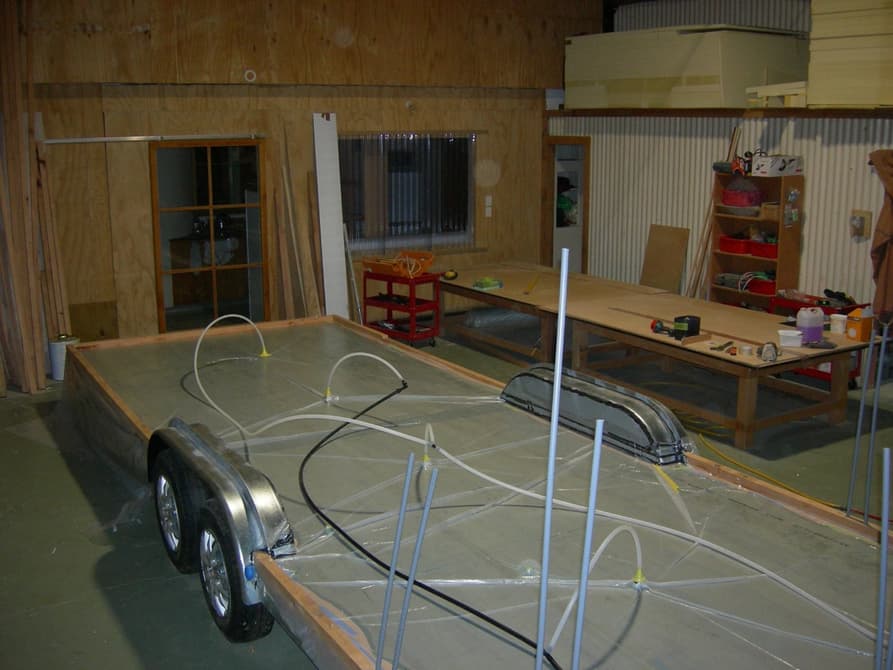
The ground level of the home measures 16.75 sq m (180.3 sq ft) and features a multi-purpose living zone, a large fully equipped kitchen, bathroom with a walk-in shower and composting toilet, a small office area and combustion fireplace. The living room is filled with natural light due to the inclusion of multiple large windows, a central skylight and double glass doors which open out onto a wooden terrace.
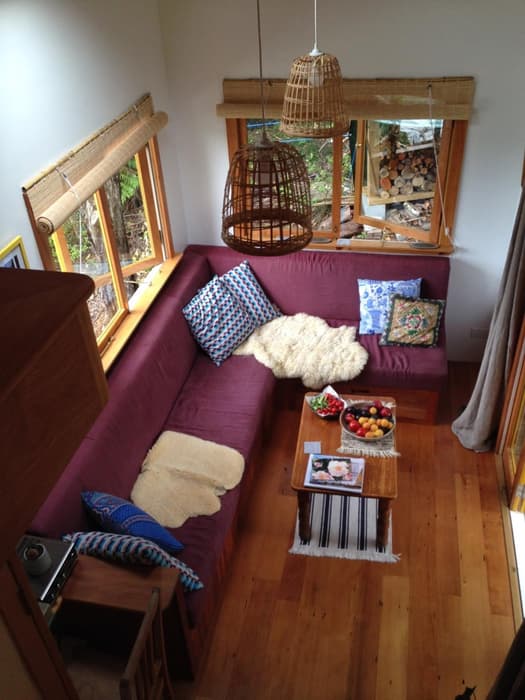
The outdoor terrace wraps around three quarters of the dwelling, adding the feeling of extra room and expansiveness to the home. The tiny house also features an elevated loft bedroom, measuring 7.2 sq m (77.5 sq ft).

The lounge area can double as a guest bedroom, with the L-shaped sofa easily transforming into a double bed. The loft bedroom, which has a queen-sized bed, also features an additional sleeping space where the owner's young niece stays sometimes. The kitchen features a two burner gas stove with overhead range-hood, an oven/grill, 130 liter under-bench fridge, cupboard and storage space, wall pantry and a sink hand-made by owner.
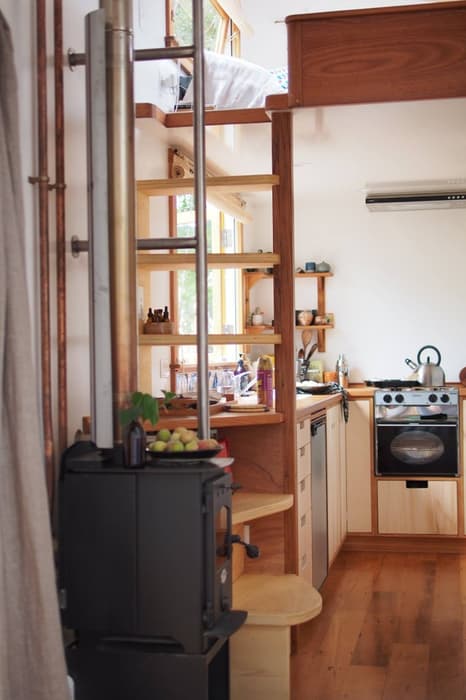
"One of my favorite features of the home is the staircase because we wrestled so hard to get stairs that looked good, that were safe, not too expensive and functional," says Hobbs. "We obtained all this plus we managed to put extra storage underneath them."
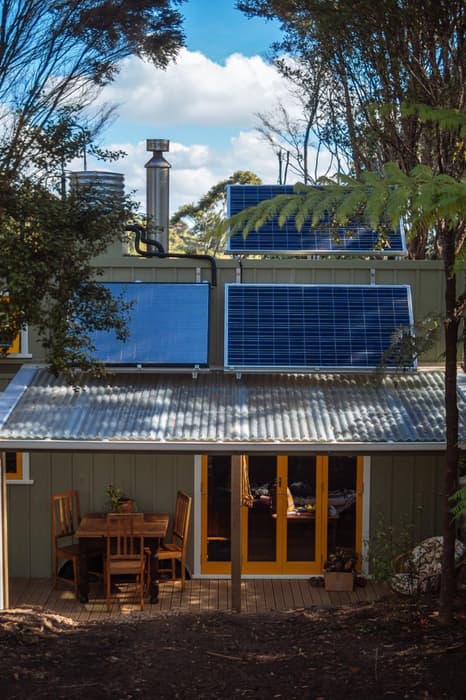
The tiny house features a series of sustainable features, including a solar collector used to heat the water, which feeds into a 90 liter (approx. 24 gallon) water tank located on the home's roof. A wet back is also connected to this tank from the small fireplace, providing hot water during the winter.
"The water system is low pressure and is fed by a 110 liter (29 gallon) header tank," says Hobbs. "This means you use less water and the shower uses only four liters of water per minute. It's a nice shower though and we are very happy with the Separette villa 9010 composting toilet. It has no smell and the urine diverter goes directly into the grey water tank, making it very low maintenance."
Grey water is collected into a 200 liter (approx. 53 gallon) tank via a stainless steel mesh which strains all food waste and hair etc. The water is pumped out into the garden on a weekly basis, and the strainer is emptied onto the compost heap. The home also features two 300 watt solar panels located on the roof. The panels are hooked up to a 12 volt battery bank with a capacity of 445 amp hours. A 1,300 watt Outback inverter runs the washing machine.

The overall costs of the materials to build this tiny house were higher than your usual tiny build, coming to a total of NZ$75,000 (about US$50,250). The home took 2,400 hours to construct, with the owner paying a final figure of NZ$130,000 (about US$87,100).
"I make double that amount building boats, but these little houses are very satisfying to create," says Hobbs. "We wanted to create something that was functional, beautiful and that would last a long time. Hopefully it will become a classic in 50 years and I know they will be quicker to build in the future. Our biggest difficulty was building the tiny house in a time frame that made it affordable for both the owner and where the builder didn't go without in the process. We started building this one in April and finished in December 2015. Most of the time there were two of us working on the project at a time."
Hobbs is currently building a tiny house shell for his son and his girlfriend, and although he is tempted to go back to boat building for the money, he is passionate about the tiny house movement and the freedom it offers the younger generation.
"I love working with small spaces, because of the challenges to achieve function and beauty," Hobbs explains. "I hope I can work out a way of making SIPs available to young people so they can make their own tiny houses to a high standard. I would love it if bio foam became more affordable or even available in New Zealand as polyurethane foam is oil based, but I'm convinced SIPs are the future for tiny houses, especially when they are on wheels. I'd like to be able to help in some way to make the tiny house movement become a practical and viable option for young people and for the older too. My hope is for urban tiny house villages, all self-sustainable, using gardens to deal with the grey water."
Gizmag


.png?w=367&h=206&mode=crop)
.jpg?w=367&h=206&mode=crop)



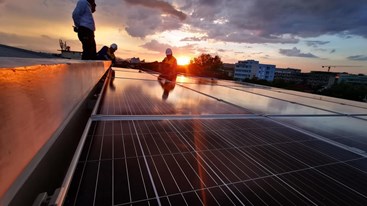
.jpg?w=367&h=206&mode=crop) Energy efficiency and conservation usage is an important aspect of the national energy development strategy
Energy efficiency and conservation usage is an important aspect of the national energy development strategy
 Challenges and Opportunities to promote energy efficiency market in Vietnam
Challenges and Opportunities to promote energy efficiency market in Vietnam
 The Ministry of Industry and Trade requests government agencies to coordinate in organizing Earth Hour 2024
The Ministry of Industry and Trade requests government agencies to coordinate in organizing Earth Hour 2024
 Consultation on Energy Efficiency Boiler Catalogue and Wood Drying Guideline
Consultation on Energy Efficiency Boiler Catalogue and Wood Drying Guideline
 Son Ha Co., Ltd, applies energy efficiency and conservation measures
Son Ha Co., Ltd, applies energy efficiency and conservation measures
 Phuc Kien Co., Ltd., is effectively implementing energy-saving measures
Phuc Kien Co., Ltd., is effectively implementing energy-saving measures
.png?w=367&h=206&mode=crop) Request for expression of interest - C2.1.13: Capacity Building on energy efficiency policies development
Request for expression of interest - C2.1.13: Capacity Building on energy efficiency policies development